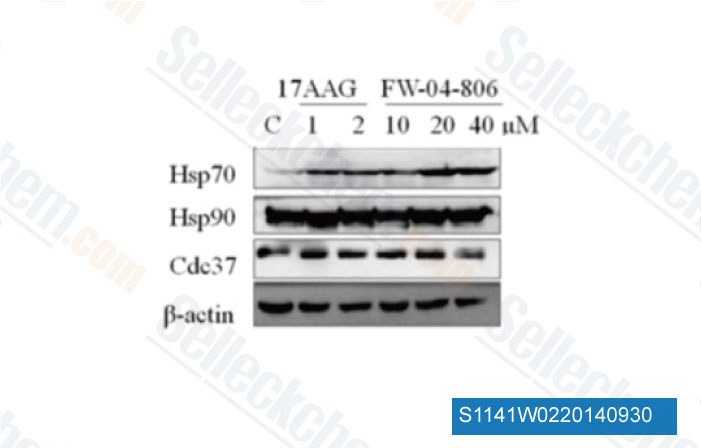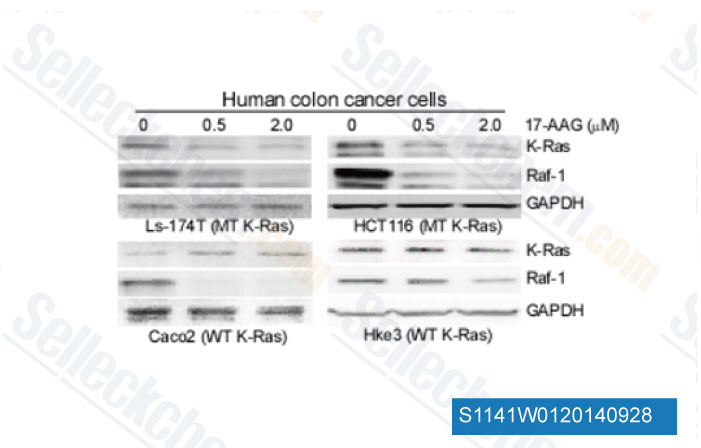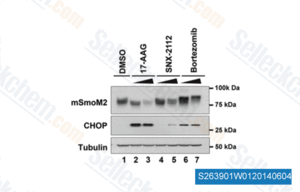|
Toll Free: (877) 796-6397 -- USA and Canada only -- |
Fax: +1-832-582-8590 Orders: +1-832-582-8158 |
Tech Support: +1-832-582-8158 Ext:3 Please provide your Order Number in the email. |
Technical Data
| Formula | C31H43N3O8 |
||||||
| Molecular Weight | 585.69 | CAS No. | 75747-14-7 | ||||
| Solubility (25°C)* | In vitro | DMSO | 117 mg/mL (199.76 mM) | ||||
| Ethanol | 5 mg/mL (8.53 mM) | ||||||
| Water | Insoluble | ||||||
| In vivo (Add solvents to the product individually and in order) |
|
||||||
|
* <1 mg/ml means slightly soluble or insoluble. * Please note that Selleck tests the solubility of all compounds in-house, and the actual solubility may differ slightly from published values. This is normal and is due to slight batch-to-batch variations. * Room temperature shipping (Stability testing shows this product can be shipped without any cooling measures.) |
|||||||
Preparing Stock Solutions
Biological Activity
| Description | Tanespimycin (17-AAG, CP127374, NSC-330507, KOS 953) is a potent HSP90 inhibitor with IC50 of 5 nM in a cell-free assay, having a 100-fold higher binding affinity for HSP90 derived from tumour cells than HSP90 from normal cells. It induces apoptosis, necrosis, autophagy and mitophagy. Phase 3. | ||
|---|---|---|---|
| Targets |
|
||
| In vitro | Tanespimycin (17-AAG), an analog of geldanamycin, exhibits greater than 100 times higher binding affinity for Hsp90 derived from HER-2-overexpressing cancer cells (BT474, N87, SKOV3 and SKBR3) or BT474 breast carcinoma cells with IC50 values of 5-6 nM. [1] It causes the degradation of HER2, HER3, Akt, and both mutant and wild-type androgen receptor (AR), leading to the RB-dependent G1 growth arrest of prostate cancer cells such as LNCaP, LAPC-4, DU-145, and PC-3 with IC50 values of 25-45 nM. [2] In addition to inducing apoptosis of Ba/F3 cells transformed with wild-type BCR-ABL with an IC50 of 5.2 μM, this compound has the ability to induce apoptosis of cells transformed with T315I and E255K BCR-ABL mutants with IC50 values of 2.3 μM and 1.0 μM, respectively, by inducing the degradation of both wild-type BCR-ABL protein and mutants. [3] |
||
| In vivo | Tanespimycin (17-AAG) displays significantly higher binding affinity for Hsp90 from 3T3-src, B16 or CT26 xenografts in nude mice with IC50 values of 8-35 nM as compared with that from the normal tissues with IC50 values of 200-600 nM. [1] Administration of this compound (~50 mg/kg) causes significant decline in AR, HER2, HER3, and Akt expression in a dose-dependent manner with >50% decline at dose of 50 mg/kg, resulting in the dose-dependent inhibition of androgen-dependent (CWR22) and -independent (CWR22R and CWRSA6) prostate cancer xenografts growth by 67%, 80% and 68% at dose of 50 mg/kg, respectively. [2] |
||
| Features | Displays very low toxicity toward normal cells. |
Protocol (from reference)
| Kinase Assay: |
|
|---|---|
| Cell Assay: |
|
| Animal Study: |
|
References
|
Customer Product Validation

-
Data from [ Mol Cancer , 2014 , 13, 150 ]

-
Data from [ Oncotarget , 2014 , 5, 4269-82 ]

-
Data from [ Mol Cell Biol , 2013 , 33(12), 2375-87 ]

-
Data from [ Age , 2013 , 35, 549-62 ]
Selleck's Tanespimycin (17-AAG) Has Been Cited by 155 Publications
| A patient-derived T cell lymphoma biorepository uncovers pathogenetic mechanisms and host-related therapeutic vulnerabilities [ Cell Rep Med, 2025, S2666-3791(25)00102-8] | PubMed: 40147445 |
| TBK1 is a signaling hub in coordinating stress-adaptive mechanisms in head and neck cancer progression [ Autophagy, 2025, 1-23.] | PubMed: 40114316 |
| NASP implication in the androgen receptor associated with castration resistance in prostate cancer [ Cell Commun Signal, 2025, 23(1):331] | PubMed: 40640803 |
| HSP90 deficiency promotes cholesteryl ester accumulation in lipid droplets via endocytosis of low-density lipoprotein [ Commun Biol, 2025, 8(1):1169] | PubMed: 40770403 |
| Heat shock protein 90 chaperone activity is required for hepatitis A virus replication [ J Virol, 2025, e0050225] | PubMed: 40470959 |
| Targeting HSP90 with Ganetespib to Induce CDK1 Degradation and Promote Cell Death in Hepatoblastoma [ Cancers (Basel), 2025, 17(8)1341] | PubMed: 40282517 |
| Topical application of the HSP90 inhibitor 17-AAG reduces skin inflammation and partially restores microbial balance: implications for atopic dermatitis therapy [ Sci Rep, 2025, 15(1):21245] | PubMed: 40593012 |
| Role of the NuRD complex and altered proteostasis in cancer cell quiescence [ bioRxiv, 2025, 2025.02.10.637435] | PubMed: 39990343 |
| Pan-cancer proteogenomics expands the landscape of therapeutic targets [ Cell, 2024, S0092-8674(24)00583-X] | PubMed: 38917788 |
| Pan-cancer proteogenomics expands the landscape of therapeutic targets [ Cell, 2024, S0092-8674(24)00583-X] | PubMed: 38917788 |
RETURN POLICY
Selleck Chemical’s Unconditional Return Policy ensures a smooth online shopping experience for our customers. If you are in any way unsatisfied with your purchase, you may return any item(s) within 7 days of receiving it. In the event of product quality issues, either protocol related or product related problems, you may return any item(s) within 365 days from the original purchase date. Please follow the instructions below when returning products.
SHIPPING AND STORAGE
Selleck products are transported at room temperature. If you receive the product at room temperature, please rest assured, the Selleck Quality Inspection Department has conducted experiments to verify that the normal temperature placement of one month will not affect the biological activity of powder products. After collecting, please store the product according to the requirements described in the datasheet. Most Selleck products are stable under the recommended conditions.
NOT FOR HUMAN, VETERINARY DIAGNOSTIC OR THERAPEUTIC USE.
